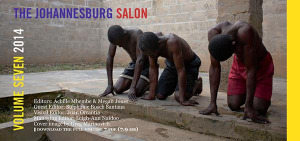JWTC Announcement: Volume Seven Of The Johannesburg Salon Goes Live!
 We are pleased to announce the publication of the next volume of the Johannesburg Salon. Volume 7 centres on a collection of essays convened for Achille Mbembe’s African Future Cities Seminar, held at Harvard University in Autumn of last year. Edited by Stephanie Bosch Santana, the pieces explore the continent’s diverse urbanisms with an eye towards future trajectories of inventiveness, fortification, resilience and segregation.
We are pleased to announce the publication of the next volume of the Johannesburg Salon. Volume 7 centres on a collection of essays convened for Achille Mbembe’s African Future Cities Seminar, held at Harvard University in Autumn of last year. Edited by Stephanie Bosch Santana, the pieces explore the continent’s diverse urbanisms with an eye towards future trajectories of inventiveness, fortification, resilience and segregation.
In our Editorial section, artist Raimi Gbadamosi remembers the late Stuart Hall, Ashleigh Harris discusses style in recent diasporic African fiction, Helena Chavez Mac Gregor explores emergent political formations in Mexico and elsewhere, Lewis Gordon ruminates on the philosophical blues, Jonathan Klaaren reflects on the limits of the South African legal system and Ellison Tjirera makes a case for Windhoek’s city-ness. Catherine Portevin interviews Achille Mbembe (in French) about how his book Critique de la Raison Negre draws on the theories of Frantz Fanon and others to enter into dialogue with Immanuel Kant’s Critique of Pure Reason. The AFC symposium is complemented by Bregtje van der Haak’s exclusive interview with Rem Koolhaas, in which the architect meditates upon the meanings and possibilites of his Lagos Project, now fifteen years old.
Juan Orrantia’s Dialogues. A southern conversation, which makes up the ZONE 3, incorporates the following two conversations and accompanying images:
A conversation between Lola Mac Dougall and photographer Gauri Gill about developing her practice beyond a Euro-centric paradigm, about privacy and the multiple readings of her work, particularly the Birth Series (2005), reproduced herewith.
A dialogue between critic/curator Renuka Sawhney and artist Naeem Mohaiemen who have been speaking to each other for some time now about the role of memory as part of a critical approach and form of work(ing) with(in) contested political spaces is unpacked through its manifestation in various locations.
A project of the Johannesburg Workshop in Theory and Criticism (JWTC), The Salon is an intellectual, political and cultural digital magazine. It is open to scholars, writers, artists, designers, architects, activists and public intellectuals who want to shape conversation from the global South while testing their works and ideas against unanticipated modes of everyday life in an uncertain world.
The Salon blurs the lines that separate print from digital media. It combines maximum elegance and minimum ornamentation, transparency, minimalist aesthetics and ease of use.
Its platform has been designed by The Library, with funding from The Prince Claus Fund and support from the Faculty of the Humanities at the University of the Witwatersrand (South Africa).
The Salon’s editors are Megan Jones and Achille Mbembe.
Volume 7 and previous: http://jwtc.org.za/volume_7.htm



